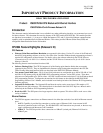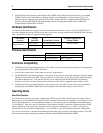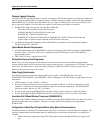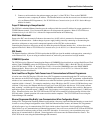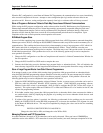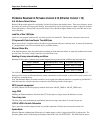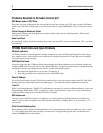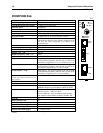
4 Important Product Information
GFK-1490C
2. Connect a serial terminal to the station manager port (port 1) of the CPU364. Then use the CHSOSW
command to enter a temporary IP address. The Ethernet Interface can then be accessed over the network (such
as by an Ethernet PLC Programmer). See TCP/IP Ethernet Communications for the IC69* Station Manager
Manual for details.
Proper IP Addressing is Always Essential
The CPU364’s embedded Ethernet Interface must be configured with the correct IP Address for proper operation in a
TCP/IP Ethernet network. Use of incorrect IP addresses can disrupt network operation. Refer to TCP/IP Ethernet
Communications for the IC69* User’s Manual for important information on IP addressing.
AAUI Cable Attachment
Power to the PLC must be turned off whenever the transceiver (AAUI) cable is connected or disconnected at the
CPU364 or at the transceiver. Sudden changes in power supply loading caused by connecting or disconnecting the
transceiver with power on may result in unexpected operation of the CPU364 or other modules.
Connecting the transceiver with power on may also blow the protective Ethernet interface fuse. A blown fuse can be
replaced in the field. Refer to TCP/IP Ethernet Communications for the IC69* User’s Manual for instructions.
SQE Enable
The Ethernet Interface within the CPU364 requires that the SQE test signal be enabled on the transceiver connecting it
to the Ethernet LAN. If you are using an external transceiver, make sure your transceiver has SQE enabled.
COMMREQ Operation
The CPU364 receives Ethernet Communications Request (COMMREQ) function blocks at a unique Rack/Slot and Task
address. Each COMMREQ sent to the CPU364 must be addressed to SYSID = 0001 (= Rack 00 / Slot 01, the location
of the CPU364) and to TASK = 21 decimal (Note: TASK = 0 is used in COMMREQs sent to the IC693CMM321
Ethernet module). Please refer to the TCP/IP Ethernet Communications for the IC69* User’s Manual for further
COMMREQ function block details.
Serial Load/Store of Register Table Causes Loss of Communications to Ethernet Programmers
A load or store of the PLC Register (%R) table from a PLC Programmer connected through the CPU serial port (using
the connector on the PLC Power Supply) can cause Ethernet applications that use the PLC programmer communications
window to lose communications. This condition occurs when the load/store operation requires more than 10 seconds to
complete (called a “timeout”). For example, transferring a large %R table to the CPU (even at 19,200 baud) may cause
a timeout. If this occurs, the Ethernet Interface will post two or more PLC faults with the text “LAN system-software
fault; resuming”, and fault-specific data starting with 080008 and/or 080042. In addition, faults with text “Bad remote
application request; discarded request” (1B0021) and “Local request to send rejected; discarded request” (110005) may
occur. When these faults occur, the STAT LED on the CPU364 will be turned off to indicate posting of faults to the
PLC fault tables. Normal operation will resume once the transfer completes. The STAT LED can be reset using the
Station Manager OK command.
Ethernet Programmer May Briefly Lose Communications When Configuration Stored
Storing a PLC configuration containing Ethernet configuration values may require the Ethernet Interface to restart itself
in order to use any changed configuration values. When the Ethernet Interface restarts, an Ethernet PLC Programmer
will briefly report a loss of communications. PLC faults similar to those listed under “Serial Load/Store of Register
Table Causes Loss of Communications to Ethernet Programmers” above will occur; and the STAT LED on the CPU364
will be turned off to indicate posting of faults to the PLC fault tables. In some cases, a ten second delay may occur
before loss of communications is detected. Normal operation will resume once the Ethernet Interface restarts. The
STAT LED can be reset using the Station Manager OK command.



